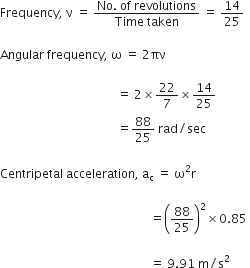A stone tied to the end of a string 80 cm long is whirled in a horizontal circle with a constant speed. If the stone makes 14 revolutions in 25 s, what is the magnitude and direction of acceleration of the stone.
Given,
Length of the string, l = 80 cm
Number of revolutions = 14
Time taken = 25 s
The direction of centripetal acceleration is always directed along the string, toward the centre, at all points.





